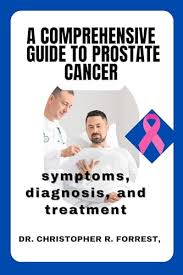Outline
1. Introduction
- Importance of prostate cancer awareness
- Overview of prostate cancer: what is it?
2. Anatomy of the Prostate
- Understanding the role of the prostate gland
- Location and function of the prostate in the male reproductive system
3. What is Prostate Cancer?
- Definition and types of prostate cancer
- The difference between aggressive and non-aggressive prostate cancer
4. Risk Factors for Prostate Cancer
- Age as a primary risk factor
- Family history and genetics
- Ethnicity and race
- Diet and lifestyle
5. Early Warning Signs and Symptoms
- Common symptoms of prostate cancer
- Asymptomatic cases: why regular screening is important
6. Prostate Cancer Screening and Detection
- Types of prostate cancer screening: PSA test and DRE
- Who should get screened and when?
- Understanding PSA levels and what they mean
7. Stages of Prostate Cancer
- How prostate cancer is staged
- Stage 1 to 4 explained
- Gleason score and its significance
8. Diagnosis of Prostate Cancer
- Diagnostic procedures: biopsy, MRI, CT scan
- Interpreting biopsy results
- Importance of second opinions in diagnosis
9. Treatment Options for Prostate Cancer
- Active surveillance for low-risk cases
- Surgery: Radical prostatectomy and its types
- Radiation therapy: External beam radiation and brachytherapy
- Hormone therapy: How it works and when it’s used
- Chemotherapy: When is it necessary?
- New and experimental treatments: Immunotherapy and targeted therapies
10. Side Effects of Prostate Cancer Treatments
- Short-term vs long-term side effects
- Incontinence and erectile dysfunction
- Managing side effects with lifestyle changes and rehabilitation
11. Prostate Cancer Recurrence
- Risk of recurrence after treatment
- Monitoring for recurrence: PSA tests and other indicators
- Treatment options for recurrent prostate cancer
12. Coping with Prostate Cancer
- Psychological impact of a prostate cancer diagnosis
- Support systems: Family, friends, and support groups
- The role of mental health professionals
13. Prevention of Prostate Cancer
- Diet and lifestyle modifications
- Role of exercise in prostate health
- Medications and supplements that may reduce risk
14. Prostate Cancer and Sexual Health
- How treatment affects sexual function
- Strategies for improving sexual health after treatment
- Counseling and therapy for intimacy issues
15. Living with Prostate Cancer: Long-Term Outlook
- Survival rates and prognosis
- Life after treatment: Follow-up care and monitoring
- Quality of life considerations
16. Prostate Cancer in Younger Men
- The rise in prostate cancer diagnoses in men under 50
- Unique challenges younger men face
- Fertility concerns and preservation options
17. Innovations in Prostate Cancer Research
- Advances in early detection methods
- New treatments on the horizon: Genetic research and precision medicine
- Clinical trials and how to get involved
18. Conclusion
- Importance of regular screening and early detection
- Encouraging proactive prostate health care
- Summary of key points for awareness
19. FAQs
- What is the survival rate for prostate cancer?
- Can prostate cancer be cured?
- At what age should men start screening for prostate cancer?
- Is prostate cancer hereditary?
- What lifestyle changes can reduce the risk of prostate cancer?
Understanding Prostate Cancer: A Comprehensive Guide to Diagnosis, Treatment, and Prevention
1. Introduction
Prostate cancer is one of the most common cancers affecting men, particularly those over the age of 50. It is estimated that 1 in 8 men will be diagnosed with prostate cancer during their lifetime. Although the survival rate for prostate cancer is relatively high when detected early, understanding the disease, its risk factors, symptoms, and treatment options is crucial for effective management and prevention.
This guide will provide a detailed overview of prostate cancer, from its definition and risk factors to screening, treatment, and long-term outcomes. By the end of this article, you’ll have a comprehensive understanding of prostate cancer and be better equipped to discuss prostate health with your doctor.
2. Anatomy of the Prostate
The prostate is a small, walnut-sized gland located below the bladder and in front of the rectum. It is part of the male reproductive system and plays a crucial role in producing seminal fluid, which nourishes and transports sperm during ejaculation.
Despite its small size, the prostate can cause significant health issues, particularly as men age. Prostate cancer arises when cells in the prostate grow uncontrollably, often leading to serious health complications if not detected and treated early.
3. What is Prostate Cancer?
Prostate cancer occurs when abnormal cells in the prostate gland begin to grow and divide more rapidly than normal cells. These cancerous cells can form tumors, which may eventually spread to other parts of the body (metastasize) if not treated.
There are different types of prostate cancer, but the most common is adenocarcinoma, which develops in the glandular tissue of the prostate. Prostate cancer can vary in aggressiveness, with some cases growing slowly (low-risk or non-aggressive) and others being more aggressive and spreading quickly.
4. Risk Factors for Prostate Cancer
Several factors can increase the risk of developing prostate cancer, some of which are beyond our control, while others can be managed through lifestyle changes:
- Age: The risk of prostate cancer increases significantly with age, with most cases diagnosed in men over 50.
- Family History and Genetics: Men with a family history of prostate cancer are at a higher risk, particularly if a father or brother was diagnosed with the disease. Certain genetic mutations, such as BRCA1 and BRCA2, can also increase the likelihood of developing prostate cancer.
- Ethnicity and Race: African American men are more likely to develop prostate cancer than men of other races, and their cancer tends to be more aggressive.
- Diet and Lifestyle: A diet high in red meat and dairy products, along with low intake of fruits and vegetables, may contribute to an increased risk of prostate cancer. A sedentary lifestyle and obesity are also linked to higher prostate cancer risk.
5. Early Warning Signs and Symptoms
One of the challenges of diagnosing prostate cancer early is that it often presents no symptoms in its initial stages. However, as the cancer progresses, certain signs may begin to appear:
- Difficulty urinating or a weak urine stream
- Frequent urination, especially at night
- Blood in the urine or semen
- Pain or discomfort in the pelvic area or lower back
- Erectile dysfunction
It’s important to note that these symptoms can also be caused by benign conditions like benign prostatic hyperplasia (BPH), a non-cancerous enlargement of the prostate. Therefore, if you experience any of these symptoms, it’s crucial to see a doctor for further evaluation.
6. Prostate Cancer Screening and Detection
Prostate cancer screening is vital for detecting the disease in its early stages when treatment is most effective. Two main screening methods are used:
- Prostate-Specific Antigen (PSA) Test: This blood test measures the level of PSA, a protein produced by the prostate. Elevated PSA levels can indicate prostate cancer, but high PSA can also result from non-cancerous conditions like BPH or prostatitis.
- Digital Rectal Exam (DRE): During this test, a doctor inserts a gloved finger into the rectum to feel the prostate for abnormalities such as lumps or hard areas.
Who should get screened? Men over the age of 50 are generally advised to discuss prostate cancer screening with their healthcare provider. However, men at higher risk, including those with a family history of prostate cancer or African American men, may need to start screening earlier, around age 40 or 45.
7. Stages of Prostate Cancer
The stage of prostate cancer refers to the extent of the disease, from how much it has grown to whether it has spread beyond the prostate. Staging is a crucial factor in determining treatment options and prognosis. Prostate cancer is typically staged using the TNM system:
- Stage 1: Cancer is small, confined to the prostate, and not detectable through DRE.
- Stage 2: Cancer is still within the prostate but may be detected via DRE or PSA tests.
- Stage 3: Cancer has spread beyond the prostate to nearby tissues, such as the seminal vesicles.
- Stage 4: Cancer has spread to distant organs, such as the lymph nodes, bones, or other parts of the body.
The Gleason score is also used to assess the aggressiveness of prostate cancer. This score ranges from 6 to 10, with higher scores indicating more aggressive cancer.
8. Diagnosis of Prostate Cancer
If screening tests suggest the presence of prostate cancer, further diagnostic tests are needed to confirm the diagnosis:
- Biopsy: A biopsy involves taking small samples of prostate tissue to examine under a microscope. This is the definitive way to diagnose prostate cancer.
- MRI and CT Scan






